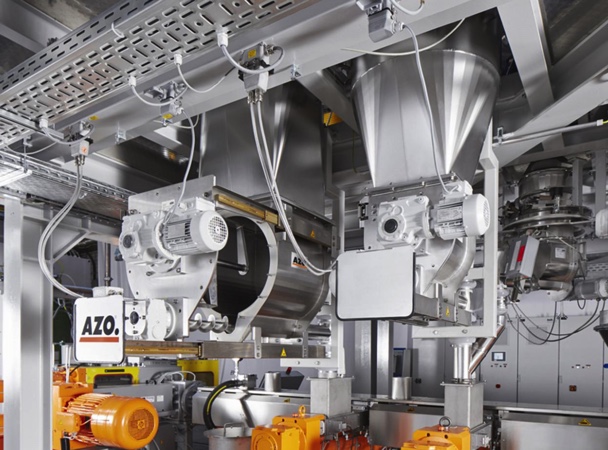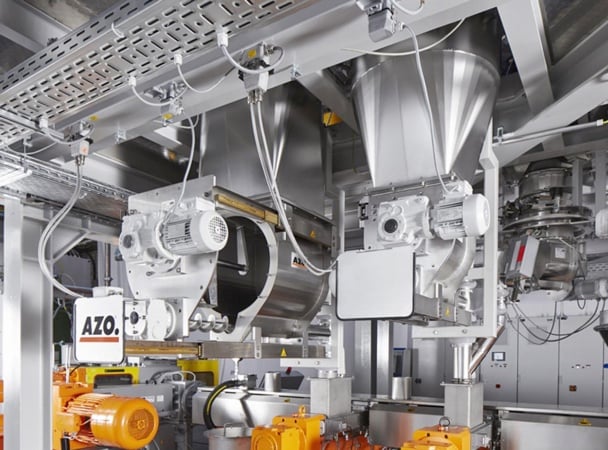
Precise amounts of ingredients for processes with a specific design or formula are what the AZODOS dosing unit is built to handle. Whether utilized in the food, pharmaceutical, chemical or plastic industries, this innovation can effectively manage finite amounts of ingredients for production processes that require a course or fine flow at a uniform mass flow rate.
With applications that deal with exact amounts (accurate to plus or minus half a gram of material), an AZODOS introduces a consistent and constant stream of ingredients into the conveying process. In this post, we’ll highlight some key factors of this customer-driven dosing device and explain how the AZODOS can improve your manufacturing process.
The AZODOS models offer both volumetric and gravimetric feeding
There are three different AZODOS model types (DV, DW and DDW). There are also five different model sizes of the AZODOS (P30, P50, P70, P100 and P140). The AZODOS DV model is the volumetric dosing version, which does not contain a scale. This can be used to feed a scale hopper, for example. The DW model is a dosing unit that has an integral scale and utilizes negative scaling. The feeder scaling is accomplished within system controls.
The DDW model uses the loss-in-weight principle by allowing speed adjustments to provide a constant rate for a completely continuous process to the downstream equipment (e.g. an extruder). All the loss-in-weight feeding, as well as calibrating, is accomplished within the control system of the AZODOS DDW model. When the filling level in the DDW hopper reaches minimum weight, the refilling of the product is automatically requested. While refilling occurs, the gravimetric dosing system continues to operate controlled by the screw speed and returns to loss-in-weight mode as soon as the refill process is complete.

An AZODOS increases accuracy, reducing waste
Any manufacturing process faces challenges in eliminating major hazards to an operation’s ergonomics. Expensive ingredients are often handled manually as the ingredients themselves are of a smaller quantity. These expensive ingredients could include, for instance, separate color pigments that become part of a product-changeover. Still, there are notorious risks with manual processing compared to automating the handling of ingredients. These risks can include inherent inaccuracy, less assurance of recipe safety and an operator’s exposure to hazardous materials.
So how do you design a process to effectively handle smaller quality ingredients while increasing your tracking traceability of the ingredients and products you use? An AZODOS is particularly well-suited for applications within these contexts. For certain processes, knowing how much material you used and when you used it is simply advantageous. In other cases, it could be required by law to keep track of batches and lot numbers.
Automating your batching of small or expensive ingredients will, in the event of a product recall, result in less wasted product as you are better able to track and trace the contaminated source. Accurate tracking and tracing of specific ingredients are increased, which often lowers operating costs. Essentially, automating your material handling while keeping a more precise eye on the material itself is a powerful move that could make a definitive difference in an operation’s efficiency and manufacturing cost reduction.
The AZODOS includes a control system with an open architecture
It can be incredibly frustrating when your production shuts down due to a continuous feeder ceasing to function. Closed architecture control systems require a visit by a service technician from the feeder company to troubleshoot the problem. With open architecture control systems (like those used with an AZODOS) you can correct potential problems in-house with your staff. This reduces the time to fix the problem and operation downtime.
With the proper training (provided by AZO), you can reduce downtime by solving any issues that may arise with your continuous feeder. With an AZODOS, you can “learn to fish,” instead of waiting for your feeder company technician to arrive and “give” your operators “a fish” because they can’t troubleshoot the proprietary technology of a closed architecture feeder.
You could also liken this process to changing a tire — sure, someone could change it for you while you stand by your car waiting for them to arrive. On the other hand, if you can change the tire yourself, you can get back on the road faster. Similarly, the open architecture of an AZODOS control system lets you get to where you need to go with your process faster.
Wherever your operation plans to go with its processes, (either partial or full-ingredient automation), AZO Inc. has many years of experience in bringing innovative German designs to American consumers. The AZODOS is our latest innovation. AZO Inc. developed the original cyclone screener in 1949, and we haven’t stopped innovating the ingredient automation industry since. If you’d like to hear more, please contact our sales team.


